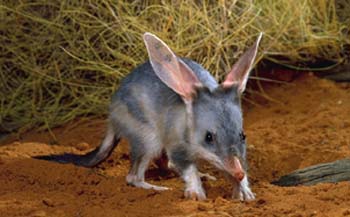
This small order of mammals consists of some lesser known marsupials -- the bandicoots and bilbies, which are native to New Guinea and Australia.
Peramelemorphs have long, pointed heads and stout bodies. The hindelimbs are longer than the forelimbs and enable the bandicoot or bilby to hop. Peramelemorphs are easily recognizable in that their 2nd and 3rd toes on the forefeet are fused together, with just the fingernails there to tell them apart.
Peramelemorphs have 7-8 polyprotodont incisors. Dasyuromorphia is also polyprotodont, but can be distinguished in that their incisors are pointed; bandicoot incisors are flattened.
Bandicoots and bilbies both have pouches (marsupiums) which face to the rear and contain the nipples.
Peramelemorphs are terrestrial mammals and feed on insects, rodents, lizards, and plants. There are 21 species, divided into 2 families based on their geographic location (New Guinea or Australia):
OLD SYSTEM
 Peramelidae (bandicoots, bilbies) 10 spp — 2 extinct
Peramelidae (bandicoots, bilbies) 10 spp — 2 extinct
 Peroryctidae (spiny bandicoots, giant bandicoots, mouse bandicoots) 11 spp
Peroryctidae (spiny bandicoots, giant bandicoots, mouse bandicoots) 11 spp Peramelidae (bandicoots, spiny bandicoots, etc)
Peramelidae (bandicoots, spiny bandicoots, etc)
 Thylacomyidae (bilbies)
Thylacomyidae (bilbies)